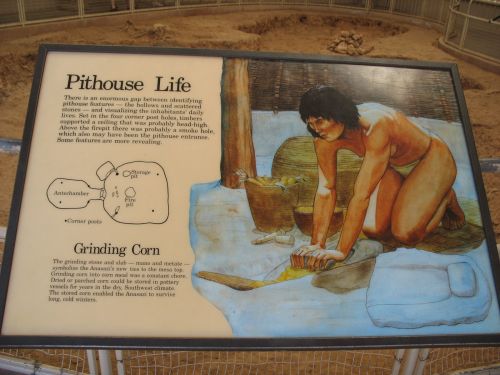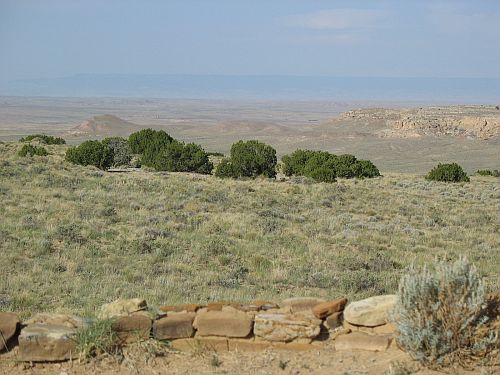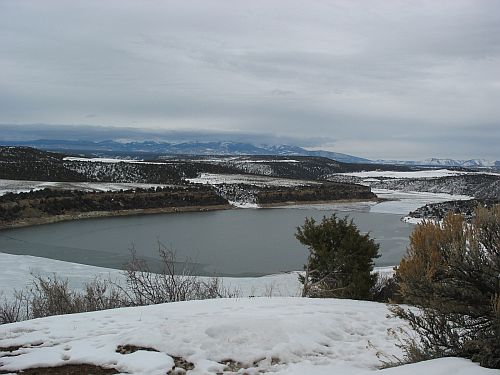
Whiteware Sherd at Una Vida
Pottery is the most important type of artifact for archaeology in the Southwest. This is because the agricultural societies of the prehistoric Southwest made huge numbers of pots and often decorated them in distinctive ways that differed both from place to place and over time, often within quite short periods. With the precision available from tree-ring dating, certain pottery types can be dated to remarkably short periods, in some cases consisting of less than 100 years, and those types in turn can be used to date unexcavated sites with no tree-ring dates of their own. Differences in decoration over time are more obvious than differences among places for most periods, which is an interesting fact that probably deserves more attention than it has gotten. Ceramic design styles changed at roughly the same times over amazingly large areas that in some cases don’t show any other evidence of substantial contact. During the Chaco era, from about AD 1030 to 1130, the dominant design style throughout the northern Southwest used a lot of hachure, for example. The specific types have different names, assigned to them by archaeologists working in different regions, and despite the general similarity in design these can be distinguished by distinctive aspects of their manufacture. These include the type of clay used for the vessel (known as the “paste”), the presence and nature of an additional type of clay (the “slip”) put on top of the paste especially for painted types, the type of paint used, and the material used to temper the clay. Tempering is the addition of some material to the paste to make it easier to work. Almost all Southwestern pottery types are tempered, and the type of tempering material is one major way different regional wares are distinguished.
To make this more concrete, let’s look at the Cibola pottery tradition, to which Chaco’s pottery belongs. There are two “wares” within this tradition: Cibola white ware and Cibola gray ware. The gray ware is the “utility ware” used for cooking pots and other mundane vessels. It is never painted, and when it has any type of decoration this typically consists of some sort of corrugation. Types of corrugation vary over time. During the height of the Chaco era, the dominant type was corrugation all over the vessel, whereas in earlier times only the neck would be corrugated. Corrugated sherds are very common at Chacoan sites, because these vessels were made in large numbers, broke frequently from heavy use, and were mostly large jars that broke into many pieces. Vessels forms are almost entirely jars rather than bowls. Temper is typically either sand (in some cases probably from ground-up sandstone) or ground-up sherds.

Black-on-white Sherd at Pueblo Alto
Cibola white ware is more complicated. This is the main “decorated” ware made at Chaco and in the area to the south of it. These vessels have the same sand- or sherd-tempered gray paste as the gray wares, but the decorated surface also has a white slip that gives vessel a white appearance from the exterior. The slips are thin and often applied in a sort of “washy” manner, and in some cases the gray paste can be seen beneath them. Designs are painted on with mineral-based paint (usually made with iron oxide), at least until about AD 1100. Forms are both jars and bowls. Jars are decorated on the exterior, while bowls are usually decorated on the interior.
Similar gray and white wares are present for most other regions during the same period. San Juan gray and white wares were made north of the San Juan River and are distinguished primarily by the use of crushed volcanic rock rather than sand or sherds as temper. The white slips on the white ware are also thicker and often highly polished. To the west, in the Kayenta area, white wares were generally painted with organic (carbon-based) paints, and over time this practice spread eastward, until after 1100 it was common in the Cibola and San Juan areas as well.

Chuska Mountains from Peñasco Blanco
A particularly important ceramic area for understanding the Chaco system is the Chuska Mountain area to the west, along the Arizona-New Mexico border. In regional ceramic terms this area basically separates the Cibola and Kayenta traditions, and in some ways it was transitional between the two. Chuskan potters adopted carbon paint earlier than those in the Cibola and San Juan areas, so imported white wares from the Chuskas to Chaco are typically carbon-painted although the designs on them are generally the same as local types. The thing that really distinguishes Chuska pottery, though, is temper. Chuskan ceramics are nearly universally tempered with trachyte, a rare and very obvious type of volcanic rock that outcrops only in a small area in the Chuskas. Trachyte-tempered pottery is therefore virtually guaranteed to have been imported from the Chuskas.
Why is this? Because potters are generally thought to have used local materials for temper (and for clay, but pinpointing clay sources is much more difficult). Designs might be similar over a wide area, but if the temper in a vessel is a material only found in a very restricted area, it’s virtually certain that the vessel was made near there. Unfortunately, most of the materials used for temper in the Southwest are very widespread; there’s sand everywhere, sherds would be present wherever anyone had broken pottery (so, again, everywhere), and the types of volcanic rock used in the San Juan region were quite widespread. Luckily, however, trachyte-tempered Chuska pottery is an exception to this, which makes it very easy to identify imports from the Chuska area at Chaco and elsewhere.

Corrugated Grayware Sherd at Wijiji
There are other ways to determine the source areas for pottery. X-ray fluorescence (XRF) and instrumental neutron activation analysis (INAA) are two widely-used methods of determining clay sources by the concentrations of trace elements in sherds, but they are very expensive and the results can be difficult to interpret. Some studies using these techniques have been done in the Southwest, and a database of element concentrations for different source areas is beginning to develop. At Chaco, however, analysis of pottery sources has so far depended primarily on the more traditional techniques of looking at paint, slip, and especially temper. The biggest study was that done in connection with the Chaco Project, the results of which were presented in a 1997 publication by Wolky Toll and Peter McKenna (available on the Chaco Archive website). Some of the data from this study was also used by Toll in his 2001 article that I have discussed before.
In brief, what Toll and McKenna found was that the Chacoans imported a lot of pottery. The amounts of imports and their sources varied over time, however. Imports were relatively rare before AD 800, making up 16.6% of the sample, but they came from a variety of sources, including the Chuskas, the San Juan region, and the Mogollon region to the south, which has very distinctive brownwares that are obvious imports when they appear. Trachyte temper is only present in 3.6% of the total sample. The period from 800 to 920 has a rather small sample from the Chaco Project excavations, but an increase in imported ceramics is apparent, with 28.1% imports and 9.7% trachyte-tempered. The most common non-local temper, however, was chalcedonic sandstone, thought to come from the area to the south of Chaco, which comprised 13.2% of the ceramics from this period. This is consistent with other evidence for intense contact with the area to the south at this time.

Pots from Early Periods at Chaco Museum
From 920 to 1040, overall imports drop slightly to 25.1%. Chalcedonic sandstone drops to 7.9%, while trachyte rises to 12.3%, the highest percentage for any specific type of import. This trend continues in the following period, from 1040 to 1100, which corresponds to the height of the Chaco system and the construction of most of the great houses in the canyon. The overall percentage of imports rises to 39.8%, with almost all of that (30.7%) being trachyte-tempered. It’s well-known that many other goods were being imported from the Chuskas at this time, especially wood, so it’s not surprising that Chuskan pottery would also have been popular. There were a lot of Chacoan great houses and communities in the Chuska area, which seems to have been closely integrated into the overall Chacoan system, perhaps to a greater degree than other “outlying” areas. The shift from south to west in the focus of the system seen in the pottery data is echoed in other types of evidence from this period.
The trend toward higher imports reaches a peak in the 1100 to 1200 period, which includes the end of Chaco’s regional dominance (but perhaps also its peak). Imports constitute an astonishing 50.4% of all the ceramics from this period, and trachyte-tempered pots comprised 31.3%, a gain in overall percentage from the previous period but a loss relative to other imported types. Chalcedonic sandstone continued to decline, while Kayenta wares increased to 4.8% after never having exceeded 1% before. It’s important to note, however, that the sample from this period is much smaller than that for the previous period and it may not be totally representative. The last period, from 1200 on, has a very small sample but continues to show a high percentage of overall imports (45.7%). Trachyte drops to 21.6%, and San Juan wares skyrocket to 16.4% after never having exceeded 5% before. This shift to the north for ceramic sources surely has to do with the relative decline of Chaco in this period and the rise of centers to the north, especially Aztec, which probably succeeded Chaco as the center of whatever Chaco had been the center of. This is also the period during which Mesa Verde became a major population center, but despite the fact that the main decorated white ware type is known as “Mesa Verde Black-on-white” it’s unlikely that many of the San Juan wares found at Chaco came from Mesa Verde itself. It’s much more likely that they came from Aztec or elsewhere in the Totah area, which had much closer ties to Chaco than Mesa Verde proper ever had.

Pots from Later Periods at Chaco Museum
So basically, the pattern that emerges from the ceramic data is of a shift in imports from the south to the west as the Chaco system really got going, followed by a shift to the north as it faltered or changed. This is paralleled in other types of artifacts, as well as in settlement patterns. The outlying communities to the south in the Red Mesa Valley were being abandoned in the late eleventh century even as new outliers like Salmon were being built to the north. There are enough lines of evidence pointing in this direction to suggest that it corresponds to something real, but it’s hard to say what exactly was going on and why.
It’s also important to note the weaknesses in this analysis. Remember, this is Chaco Project data. It doesn’t include any of the pottery excavated from Pueblo Bonito, Chetro Ketl, Pueblo del Arroyo, or any other sites excavated prior to the 1970s. It also has a heavy bias toward data from Pueblo Alto, which as I’ve mentioned before can be problematic in overall interpretations of Chaco. However, at least the heavy importation of Chuska wares does seem to be supported by data from Pueblo Bonito. Anna Shepard, the ceramic analyst who pioneered many of the techniques that are now standard in the Southwest, analyzed the sherds from Neil Judd’s excavations at Bonito in the 1920s and concluded that many of them were imported from the Chuskas based on the presence of trachyte temper. Judd, who was heavily devoted to the currently prevailing notion that Pueblos were self-sufficient for utilitarian goods like pottery, was so skeptical of this finding that he actually wrote a rebuttal to Shepard’s analysis and published both in his report. As it turns out, however, Shepard was right, and ahead of her time, in seeing substantial importation of pottery to Chaco.

Corrugated Grayware Sherds at Kin Ya'a
Of course, this leaves open the question of why the Chacoans would have imported so much pottery. Was it due to a shortage of materials? Surely there was no shortage of clay or sand; Chaco may be lacking in most resources, but it has virtually inexhaustible supplies of clay and sand. Wolky Toll is inclined to think that a shortage of fuel for firing may have been a factor, and that the heavily forested Chuskas may have been a better place to find fuel and thus to make pots. Certainly local wood resources in the sparsely wooded area around Chaco would have run out quite quickly what with all the monumental construction, but I don’t really buy this. Wood isn’t the only type of fuel you can use to make fires. There is plenty of evidence that the Chacoans burned corncobs and other material in their domestic hearths, and Toll and McKenna refer in their report to an apparent pottery production location in the Chuskas, dating to Basketmaker III times, that was not near wood sources but did have “complex hearths with substantial fuel waste build up (primarily corn stalks).”
So if not for lack of fuel, why all the imports? One clue may come from the types of vessels imported. The Chuska imports were primarily gray ware utility vessels, which were used for cooking. It has been proposed that trachyte provides better resilience to thermal shock from repeated heating and cooling than other tempers, and Chuska vessels may thus have been higher-quality cooking pots than other local or imported vessels. (Similar arguments have been made for the superiority of corrugated pots as compared to plainwares.) This is certainly possible, but in light of the numerous other Chuskan imports it’s not really clear to me that functional considerations were primary determinants of Chacoan trade patterns. Maybe the Chacoans just had particularly close social and political ties to Chuskan communities, and that led to closer economic ties. A lot of this depends on the nature of the Chaco system, which of course we don’t know much about.
In any case, the large-scale importation of pottery is one of the most striking examples of how Chaco was very much at the center of a regional system. We may not know what that system was, exactly, or how it functioned, but we can see that it existed. The evidence is right there in all those potsherds that litter the ground around the sites in the canyon.

Toll, H. (2001). Making and Breaking Pots in the Chaco World American Antiquity, 66 (1) DOI: 10.2307/2694318
Read Full Post »














































